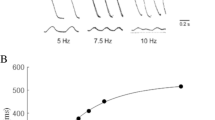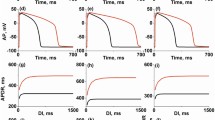Abstract
Background Gender disparities in the incidence of torsade de pointes (TdP) ventricular tachycardia exist, but the mechanisms in humans are unresolved. We addressed this issue using a mathematical model of a human ventricular cell.
MethodsWe implemented gender differences in the Priebe-Beuckelmann model cell by modifying the amplitudes of the L-type Ca2+ current (ICa,L), transient outward K+ current (Ito), and rapid component of the delayed rectifier K+current (IKr), according to experimental data from animal male and female hearts. Gender disparities in electrical heterogeneity between transmural layers (subepicardium, midmyocardium, subendocardium) were implemented by modifying various ion currents according to experimental data.
ResultsAction potentials in female cells have longer durations and steeper duration versus frequency relationships than male cells. In the female cells, electrical heterogeneity between transmural layers is larger and the susceptibility to early afterdepolarisations is higher than in male cells.
ConclusionGender-related differences in ICa,L, Ito, and IKr may explain the gender disparities in human cardiac electrophysiology. Female cells have an increased susceptibility to early afterdepolarisations following mild reductions in net repolarising forces. Combined with their greater electrical heterogeneity, this renders them more vulnerable to TdP. (Neth Heart J 2007;15:405-11.)


Similar content being viewed by others
References
James AF, Choisy SCM, Hancox JC. Recent advances in understanding sex differences in cardiac repolarization. Prog Biophys Mol Biol 2007;94:265-319.
Zareba W, Moss AJ, le Cessie S, Locati EH, Robinson JL, Hall WJ, et al. Risk of cardiac events in family members of patients with long QT syndrome. J Am Coll Cardiol 1995;26:1685-91.
Locati EH, Zareba W, Moss AJ, Schwartz PJ, Vincent GM, Lehmann MH, et al. Age- and sex-related differences in clinical manifestations in patients with congenital long-QT syndrome: findings from the International LQTS Registry. Circulation 1998;97:2237-44.
Lehmann MH, Hardy S, Archibald D, Quart B, MacNeil DJ. Sex difference in risk of torsade de pointes with d,l-sotalol. Circulation 1996;94:2535-41.
Schwartz PJ, Periti M, Malliani A. Fundamentals of clinical cardiology: the long Q-T syndrome. Am Heart J 1975;89:378-90.
Antzelevitch C, Sicouri S. Clinical relevance of cardiac arrhythmias generated by afterdepolarizations: role of M cells in the generation of U waves, triggered activity and Torsade de Pointes. J Am Coll Cardiol 1994;23:259-77.
Verduyn SC, Vos MA, van der Zande J, van der Hulst FF, Wellens HJ. Role of interventricular dispersion of repolarization in acquired torsade-de-pointes arrhythmias: reversal by magnesium. Cardiovasc Res 1997;34:453-63.
Akar FG, Yan G-X, Antzelevitch C, Rosenbaum DS. Unique topographical distribution of M cells underlies reentrant mechanism of Torsade de Pointes in the long-QT syndrome. Circulation 2002;105:1247-53.
Luo CH, Rudy Y. A dynamic model of the cardiac ventricular action potential. II. Afterdepolarizations, triggered activity, and potentiation. Circ Res 1994;74:1097-113.
Priebe L, Beuckelmann DJ. Simulation study of cellular electric properties in heart failure. Circ Res 1998;82:1206-23.
Luo CH, Rudy Y. A dynamic model of the cardiac ventricular action potential. I. Simulations of ionic currents and concentration changes. Circ Res 1994;74:1071-96.
Pham TV, Robinson RB, Danilo P Jr, Rosen MR. Effects of gonadal steroids on gender-related differences in transmural dispersion of L-type calcium current. Cardiovasc Res 2002;53:752-62.
Wu Y, Anderson ME. Reduced repolarization reserve in ventricular myocytes from female mice. Cardiovasc Res 2002;53:763-9.
Di Diego JM, Cordeiro JM, Goodrow RJ, Fish JM, Zygmunt AC, Perez GJ, et al. Ionic and cellular basis for the predominance of the Brugada syndrome phenotype in males. Circulation 2002;106: 2004-11.
Trepanier-Boulay V, St-Michel C, Tremblay A, Fiset C. Genderbased differences in cardiac repolarization in mouse ventricle. Circ Res 2001;89:437-44.
Leblanc N, Chartier D, Gosselin H, Rouleau JL. Age and gender differences in excitation-contraction coupling of the rat ventricle. J Physiol 1998;511:533-48.
Liu XK, Katchman A, Drici MD, Ebert SN, Ducic I, Morad M, et al. Gender difference in the cycle length-dependent QT and potassium currents in rabbits. J Pharmacol Exp Ther 1998;285: 672-9.
Ranki HJ, Budas GR, Crawford RM, Jovanovic A. Genderspecific difference in cardiac ATP-sensitive K+ channels. J Am Coll Cardiol 2001;38:906-15.
Li GR, Feng J, Yue L, Carrier M, Nattel S. Evidence for two components of delayed rectifier K+ current in human ventricular myocytes. Circ Res 1996;78:689-96.
Li GR, Lau CP, Ducharme A, Tardif JC, Nattel S. Transmural action potential and ionic current remodeling in ventricles of failing canine hearts. Am J Physiol Heart Circ Physiol 2002;283: H1031-41.
Sugishita K, Su Z, Li F, Philipson KD, Barry WH. Gender influences [Ca2+]i during metabolic inhibition in myocytes overexpressing the Na+-Ca2+ exchanger. Circulation 2001;104:2101-6.
Liu DW, Gintant GA, Antzelevitch C. Ionic bases for electrophysiological distinctions among epicardial, midmyocardial, and endocardial myocytes from the free wall of the canine left ventricle. Circ Res 1993;72:671-87.
Zygmunt AC, Goodrow RJ, Antzelevitch C. INaCa contributes to electrical heterogeneity within the canine ventricle. Am J Physiol Heart Circ Physiol 2000;278:H1671-8.
Zygmunt AC, Eddlestone GT, Thomas GP, Nesterenko VV, Antzelevitch C. Larger late sodium conductance in M cells contributes to electrical heterogeneity in canine ventricle. Am J Physiol Heart Circ Physiol 2001;281:H689-97.
Kligfield P, Lax KG, Okin PM. QT interval-heart rate relation during exercise in normal men and women: definition by linear regression analysis. J Am Coll Cardiol 1996;28:1547-55.
Tan HL, Hou CJY, Lauer MR, Sung RJ. Electrophysiologic mechanisms of the long QT interval syndromes and torsade de pointes. Ann Intern Med 1995;122:701-14.
Veldkamp MW, Verkerk AO, van Ginneken ACG, Baartscheer A, Schumacher C, de Jonge N, et al. Norepinephrine induces action potential prolongation and early afterdepolarizations in ventricular myocytes isolated from human end-stage failing hearts. Eur Heart J 2001;22:955-63.
Pham TV, Sosunov EA, Gainullin RZ, Danilo P Jr, Rosen MR. Impact of sex and gonadal steroids on prolongation of ventricular repolarization and arrhythmias induced by IK-blocking drugs. Circulation 2001;103:2207-12.
Zeng J, Rudy Y. Early afterdepolarizations in cardiac myocytes: mechanism and rate dependence. Biophys J 1995;68:949-64.
Verkerk AO, Wilders R, Veldkamp MW, de Geringel W, Kirkels JH, Tan HL. Gender disparities in cardiac cellular electrophysiology and arrhythmia susceptibility in human failing ventricular myocytes. Int Heart J 2005;46:1105-18.
Valverde ER, Biagetti MO, Bertran GR, Arini PD, Bidoggia H, Quinteiro RA. Developmental changes of cardiac repolarization in rabbits: implications for the role of sex hormones. Cardiovasc Res 2003:57:625-31.
Bazett HC. An analysis of the time relations of electrocardiograms. Heart 1920;7:353-67.
**ao L, Zhang L, Han W, Wang Z, Nattel S. Sex-based transmural differences in cardiac repolarization and ionic-current properties in canine left ventricles. Am J Physiol Heart Circ Physiol 2006;291: H570-80.
Yang H, Elko P, Fromm BS, Baga JJ, Pires LA, Schuger CD, et al. Maximal ascending and descending slopes of the T wave in men and women. J Electrocardiol 1997;30:267-76.
Bidoggia H, Maciel JP, Capalozza N, Mosca S, Blaksley EJ, Valverde E, et al. Sex-dependent electrocardiographic pattern of cardiac repolarization. Am Heart J 2000;140:430-6.
Lesh MD, Pring M, Spear JF. Cellular uncoupling can unmask dispersion of action potential duration in ventricular myocardium: a computer modeling study. Circ Res 1989;65:1426-40.
Viswanathan PC, Shaw RM, Rudy Y. Effects of IKr and IKs heterogeneity on action potential duration and its rate dependence: a simulation study. Circulation 1999;99:2466-74.
Author information
Authors and Affiliations
Additional information
Department of Physiology, Heart Failure Research Centre, Academic Medical Centre, University of Amsterdam, Amsterdam, the Netherlands
Departments of Experimental Cardiology and Cardiology, Heart Failure Research Centre, Academic Medical Centre, University of Amsterdam, Amsterdam, the Netherlands
Department of Physiology, Heart Failure Research Centre, Academic Medical Centre, University of Amsterdam, Amsterdam, the Netherlands
Correspondence to: H.L. Tan Department of Cardiology, Academic Medical Centre, PO Box 22660, 1100 DD Amsterdam, the Netherlands
Rights and permissions
About this article
Cite this article
Verkerk, A.O., Tan, H.L. Gender disparities in torsade de pointes ventricular tachycardia. NHJL 15, 405–411 (2007). https://doi.org/10.1007/BF03086040
Issue Date:
DOI: https://doi.org/10.1007/BF03086040




